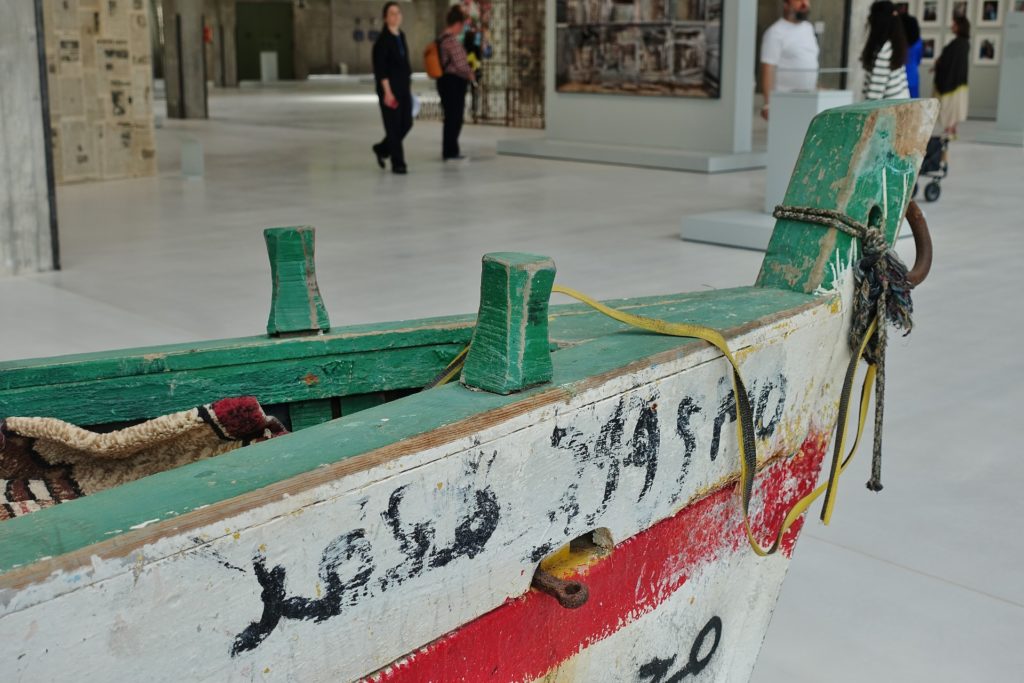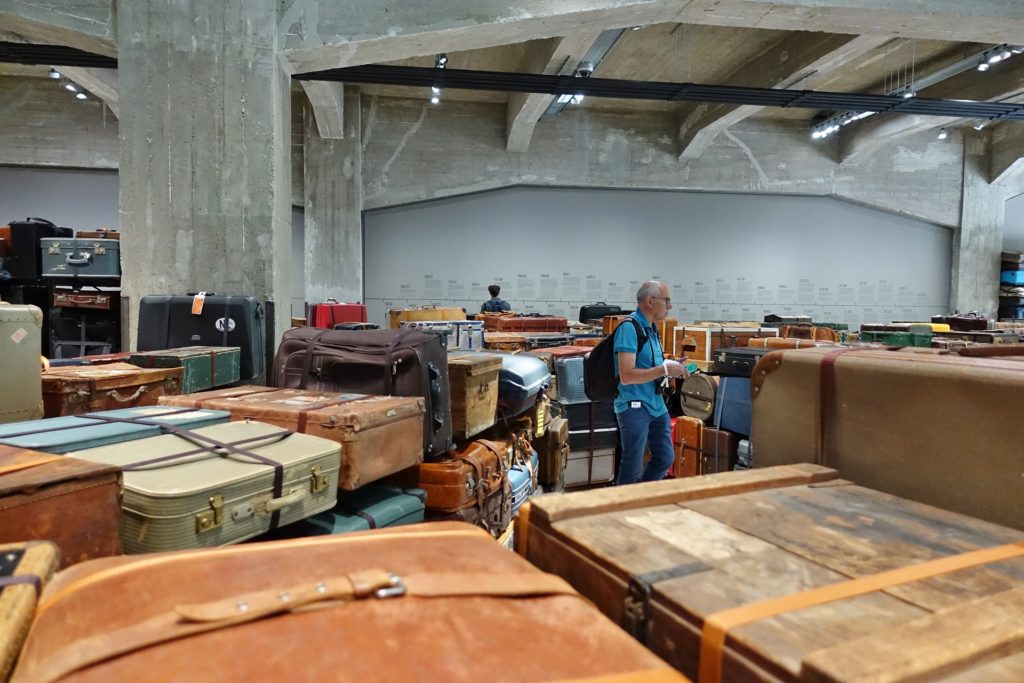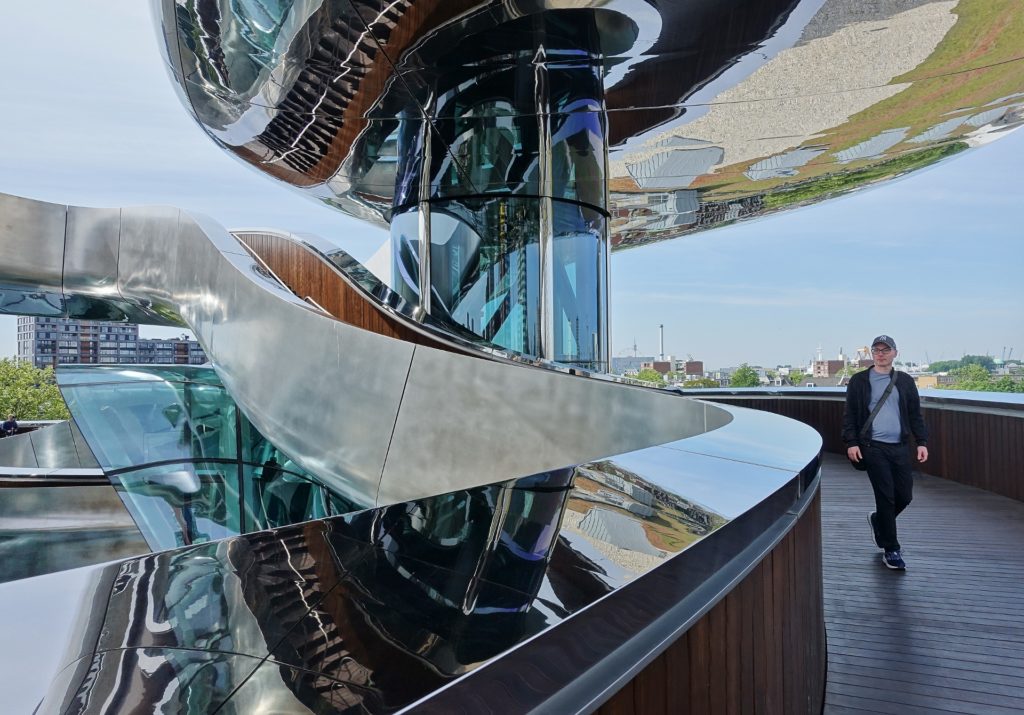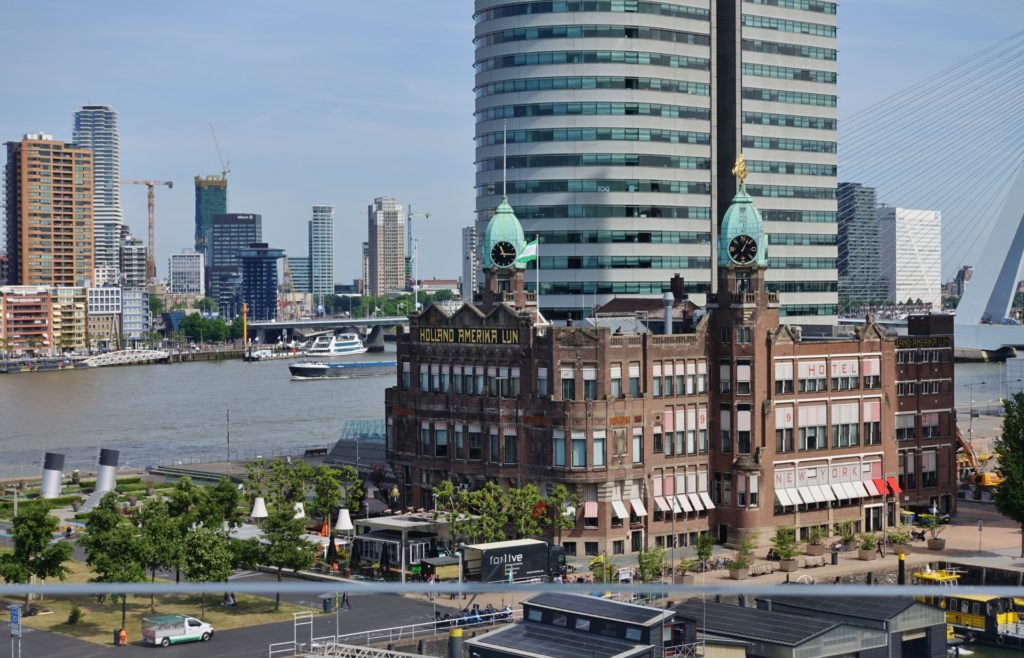I’M STARING up at a vast steel structure, rising from a former warehouse building in Rotterdam.
This is the Tornado, a double helix-shaped staircase designed by Ma Yansong of MAD Architects, with different paths that intersect at key points as you head upwards.
The idea is that you choose your own route to the rooftop, rewarded by panoramic views of the Rotterdam city skyline and what was once the world’s largest port.
From this area, millions of migrants began and ended their journeys due to war, persecution, or the need for a fresh start.
The Tornado tops off the impressive new Fenix Museum, which is all about human migration stories and migration-related art.
Suitably it’s in the Katendrecht district, which was a base for sailors and settlers from around the globe. Today, Rotterdam is proud of its multicultural roots, and Katendrecht is on the up.
Fenix is a mind-boggling place, in the best possible way, with so many narratives jostling for your attention.
A labyrinthine suitcase installation takes up one corner of the ground floor, each suitcase with its own story of displacement, hope and fear.
 Lampedusa Boat at Fenix (Pic: Allen)
Lampedusa Boat at Fenix (Pic: Allen)Opposite, a photography exhibition, Family of Migrants, documents people on the move. Amongst the emotive mix, you’ll recognise Dorothea Lange’s Migrant Mother and Steve McCurry’s Afghan Girl as iconic migration images.
Upstairs, two huge gallery spaces are interspersed with all kinds of artwork - installations, paintings, sculptures and videos - across six themes, such as Fortune and Identity.
Some pieces jump out at me instantly: a real migrant boat recovered from Lampedusa in 2022, complete with discarded water bottles; Yinka Shonibare’s Refugee Astronaut IX sculpture, desperately heading to another planet.
Others demand closer inspection: Do Ho Suh’s replicated door locks from his old homes; Moroccan-style hairpins made from Dutch coins; expressive paintings on top of residence applications by Ukrainian artist Maria Kulikovska.
I can’t help thinking Niall Conlon’s More Irish, More Blacks, More Dogs print would be a brilliant addition, countering the offensive signs (‘No blacks, no dogs, no Irish’) displayed in some English boarding house windows in the 1950s and 60s.
If you come away from this museum with anything less than profound empathy, I’d suggest you might struggle to connect with what Rotterdam represents.
 Suitcase Labyrinth at Fenix (Pics: Polly Allen)
Suitcase Labyrinth at Fenix (Pics: Polly Allen)Walking the diaspora
Taking the Landverhuizers walking tour with expert Anja Brand helps uncover more of Katendrecht’s history.
Lots of local street names reflect its past residents, like Timorstraat (Timor Street) and Sumatraweg (Sumatra Way).
The Netherlands’ colonial rule included Timor-Leste, Suriname, Indonesia, the Dutch East Indies and West Indies; many people from these lands made the journey to Rotterdam, before and after liberation.
As Anja explains, Rotterdam has residents with an estimated 206 nationalities: this figure includes unacknowledged nations such as Palestine, Tibet, Kurdistan and the Basque Country.
Anja introduces us to Jorge Oliveira Lizardo, a historian and storyteller with proud Cape Verdean heritage, whose great-uncle was legendary local figure Joao Silva, who arrived here in the 1950s and became a musician with his own record label.
“Cape Verde was a stronghold, a refuelling station and a slave market for the Portuguese and Spanish,” explains Jorge.
It’s estimated there are 23,000 people of Cape Verdean origin in the Netherlands; in fact, Rotterdam has the third biggest Cape Verdean diaspora in the world.
Many like Joao Silva arrived in the 1950s and 60s, before Cape Verdean independence from the Portuguese in 1975. The community still celebrates national festivals like Sao Joao, held every June.
Jorge’s heritage is part of the rich mix of Katendrecht: “There were different nationality boarding houses for sailors, so you’d have a Chinese boarding house and so on,” he says. “You could find people from your country.”
In fact, as we learn from meeting author David Zee, who has Chinese, Taiwanese and Dutch heritage, Katendrecht once had the biggest Chinatown in Europe.
 Fenix Museum Tornado (Pic: Polly Allen)
Fenix Museum Tornado (Pic: Polly Allen)“There were 60 Chinese boarding houses, with up to 50 people living on each floor,” he says. “By 1918, 40,000 Chinese people worked in the shipyards.
“However, the Dutch government didn’t allow marriage between Chinese and Dutch people – they referred to the Chinese as ‘Asian vermin’,” says David.
“My Dutch grandma was forced to revoke her nationality and become Chinese; the same applied to my mother. This meant they got no child support. My mother had to buy back her Dutch nationality in 1975.”
Today, things are different: the Chinese diaspora is an important part of Rotterdam’s identity, and events like Lunar New Year are celebrated here and in other major cities like The Hague and Amsterdam.
Meanwhile, in terms of the Netherlands’ post-colonial attitude, last year Rotterdam became the first Dutch city to return colonial artefacts to Indonesia. The city gave back 68 items that had been taken by Dutch military in the 19th and 20th century.
Celebrating travel and cultural exchange
Following the tour, the Story House Belvédère is a perfect pit-stop.
Since its opening in 1894, it’s been a restaurant, jazz club, Greek nightclub and a wrestling venue, but now it’s a place to find cool international events, like gigs and exhibitions, and a guest chef of the day might cook up dishes from Egypt, Iran or Argentina.
Across the water, there are further international sights, like New Ocean Paradise, a floating Chinese restaurant, garden and supermarket dating back to the 1980s.
It was built to symbolise Rotterdam and Shanghai’s status as twin cities, with their ports as gateways to the world.
Further west, I head to the photogenic Delfshaven district, which held the original city port centuries ago, where the Pilgrim Fathers set off for America in 1620. Soak up the views over 400 years later at De Pelgrim (Aelbrechtskolk 12), a waterfront restaurant and brewery with its own signature beer, Mayflower, paying tribute to the connection; squeeze in a guided brewery tour and tasting if you have time.
Near De Pelgrim there’s a great antique shop, Maritieme Kunst & Antiekhandel (Voorhaven 33), selling global maritime-related treasures such as shipping charts and maps – a 1750 map of Ireland, by Dutch publisher Isaak Tirion, amongst them.
Hotels with international roots
The Hotel New York (Koninginnenhoofd 1) was formerly the Holland America Line offices, a pivotal company in migration to America. From 1901 until the late 70s, people could buy tickets here to New York.
 The Hotel New York (Pics: Polly Allen)
The Hotel New York (Pics: Polly Allen)The building is now dwarfed by skyscrapers, but its interiors blend heritage with modern twists, like Fornasetti wallpaper and a cocktail lounge.
On a tighter budget, the 20-room Bazar (Witte de Withstraat 16) blends North African, West African and Middle Eastern influences in its cosy hotel décor – for example, Room 306 has Ghanaian motifs, whilst 308 has a sunken Ethopian-style bed.
The international flavour translates to its restaurant menu: I spot Tunisian fish soup, Persian lamb stew, and Turkish yoghurt.
Wherever you stay in Rotterdam, you can’t help but be reminded that this city is a place of transitions and cultural exchanges, where each person’s heritage or background just adds an extra something to the mix.
More ways to find diaspora culture in Rotterdam
- The Rumah (Oude Binnenweg 110C) is a cocktail bar named after the Indonesian word for ‘home’, and giving a nod to the rum-focused menu. The owners have also brought pop-up events to other European cities, like Antwerp and Düsseldorf.
- Rotterdam had an influx of Scottish migrants from the end of the 17th century, and established trade links to Scottish ports. The Scots International Church (Schiedamse Vest 121), founded in 1643, is in the city centre. Like many buildings in this area, it was destroyed in the devastating Nazi bombing of 1940 and later rebuilt.
- Reading Room Rotterdam West (Rijnhoutplein 3) is a local-run library that holds 20,000 books in different languages, many you can keep for free. It’s a useful place to study, enjoy a quiet coffee or meet people; volunteers have links to 23 different countries, including Greece, Somalia and Rwanda.
- See more of Ma Yangsong’s global architecture on display at Nieuwe Instituut (Museumpark 25). Ma Yangsong: Architecture and Emotion runs until 11 October 2025.
FACT FILE
- Visit Rotterdam and Visit Netherlands are your main sources for trip planning.
- The Landverhuizers Tour (€17.50 or £15pp), running until at least 20 July 2025, is bookable through the Story House Belvédère website.
- Rooms at Hotel New York by WestCord start at €100 or £84 per night; waterfront or pier views, €200-300 or £150-250 per night.
- Rooms at Bazar start from €75 or £63 per night.
- Rotterdam is an easy Eurostar journey from London St. Pancras or Brussels-Midi. Ferry connections are available from Hull.
- Flights to Rotterdam The Hague Airport go from 50 European or North African destinations, including Barcelona, Jersey and Rome. You can also fly to Amsterdam Schiphol Airport, with many international connections such as Dublin and Cork, and take the train on to Rotterdam.

